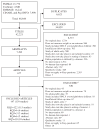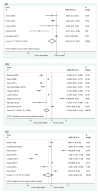What childhood obesity prevention programmes work? A systematic review and meta-analysis
- PMID: 25893796
- PMCID: PMC4561621
- DOI: 10.1111/obr.12277
What childhood obesity prevention programmes work? A systematic review and meta-analysis
Abstract
Previous reviews of childhood obesity prevention have focused largely on schools and findings have been inconsistent. Funded by the US Agency for Healthcare Research and Quality (AHRQ) and the National Institutes of Health, we systematically evaluated the effectiveness of childhood obesity prevention programmes conducted in high-income countries and implemented in various settings. We searched MEDLINE®, Embase, PsycINFO, CINAHL®, ClinicalTrials.gov and the Cochrane Library from inception through 22 April 2013 for relevant studies, including randomized controlled trials, quasi-experimental studies and natural experiments, targeting diet, physical activity or both, and conducted in children aged 2-18 in high-income countries. Two reviewers independently abstracted the data. The strength of evidence (SOE) supporting interventions was graded for each study setting (e.g. home, school). Meta-analyses were performed on studies judged sufficiently similar and appropriate to pool using random effect models. This paper reported our findings on various adiposity-related outcomes. We identified 147 articles (139 intervention studies) of which 115 studies were primarily school based, although other settings could have been involved. Most were conducted in the United States and within the past decade. SOE was high for physical activity-only interventions delivered in schools with home involvement or combined diet-physical activity interventions delivered in schools with both home and community components. SOE was moderate for school-based interventions targeting either diet or physical activity, combined interventions delivered in schools with home or community components or combined interventions delivered in the community with a school component. SOE was low for combined interventions in childcare or home settings. Evidence was insufficient for other interventions. In conclusion, at least moderately strong evidence supports the effectiveness of school-based interventions for preventing childhood obesity. More research is needed to evaluate programmes in other settings or of other design types, especially environmental, policy and consumer health informatics-oriented interventions.
Keywords: Childhood; obesity; prevention; systematic review.
© 2015 World Obesity.
Conflict of interest statement
No conflict of interest was declared.
Figures


References
-
- Wang Y, Beydoun MA. The obesity epidemic in the United States – gender, age, socioeconomic, racial/ethnic, and geographic characteristics: a systematic review and meta-regression analysis. Epidemiol Rev. 2007;29:6–28. - PubMed
-
- Centers for Disease Control (CDC) [accessed August 2013];Vital Signs: Obesity among low-income, preschool-aged children – United States, 2008–2011. http://www.cdc.gov/mmwr/preview/mmwrhtml/mm6231a4.htm. - PMC - PubMed
-
- Centers for Disease Control (CDC) [accessed August 2013];Childhood Overweight and Obesity. http://www.cdc.gov/obesity/childhood/index.html.
-
- Ogden CL, Carroll MD, Flegal KM. High body mass index for age among US children and adolescents, 2003–2006. JAMA. 2008;299:2401–2405. - PubMed
Appendix A1 PA-only interventions implemented in a school only-based setting
-
- Walther C, Gaede L, Adams V, et al. Effect of increased exercise in school children on physical fitness and endothelial progenitor cells: a prospective randomized trial. Circulation. 2009;120:2251–2259. - PubMed
-
- Stenevi-Lundgren S, Daly RM, Linden C, Gardsell P, Karlsson MK. Effects of a daily school based physical activity intervention program on muscle development in prepubertal girls. Eur J Appl Physiol. 2009;105:533–541. - PubMed
-
- Reed KE, Warburton DE, Macdonald HM, Naylor PJ, McKay HA. Action Schools! BC: a school-based physical activity intervention designed to decrease cardiovascular disease risk factors in children. Prev Med. 2008;46:525–531. - PubMed
-
- Heelan KA, Abbey BM, Donnelly JE, Mayo MS, Welk GJ. Evaluation of a walking school bus for promoting physical activity in youth. J Phys Act Health. 2009;6:560–567. - PubMed
Appendix A2 Combined interventions implemented in a school only-based setting
-
- Vandongen R, Jenner DA, Thompson C, et al. A controlled evaluation of a fitness and nutrition intervention program on cardiovascular health in 10- to 12-year-old children. Prev Med. 1995;24:9–22. - PubMed
-
- Bonsergent E, Agrinier N, Thilly N, et al. Overweight and obesity prevention for adolescents: a cluster randomized controlled trial in a school setting. Am J Prev Med. 2013;44:30–39. - PubMed
-
- Amaro S, Viggiano A, Di Costanzo A, et al. Kaledo, a new educational board-game, gives nutritional rudiments and encourages healthy eating in children: a pilot cluster randomized trial. Eur J Pediatr. 2006;165:630–635. - PubMed
Appendix A3 Interventions implemented in schools and included a home component
-
- Hendy HM, Williams KE, Camise TS. Kid’s Choice Program improves weight management behaviors and weight status in school children. Appetite. 2011;56:484–494. - PubMed
-
- Robinson TN. Reducing children’s television viewing to prevent obesity: a randomized controlled trial. JAMA. 1999;282:1561–1567. - PubMed
-
- Manios Y, Kafatos A, Mamalakis G. The effects of a health education intervention initiated at first grade over a 3 year period: physical activity and fitness indices. Health Educ Res. 1998;13:593–606. - PubMed
Appendix A4 School-based interventions with home and community components
-
- Angelopoulos PD, Milionis HJ, Grammatikaki E, Moschonis G, Manios Y. Changes in BMI and blood pressure after a school based intervention: the CHILDREN study. Eur J Public Health. 2009;19:319–325. - PubMed
-
- Greening L, Harrell KT, Low AK, Fielder CE. Efficacy of a school-based childhood obesity intervention program in a rural southern community: TEAM Mississippi Project. Obesity (Silver Spring) 2011;19:1213–1219. - PubMed
-
- Jansen W, Borsboom G, Meima A, et al. Effectiveness of a primary school-based intervention to reduce overweight. Int J Pediatr Obes. 2011;6:e70–e77. - PubMed
-
- De Coen V, De Bourdeaudhuij I, Vereecken C, et al. Effects of a 2-year healthy eating and physical activity intervention for 3–6-year-olds in communities of high and low socio-economic status: the POP (Prevention of Overweight among Pre-school and school children) project. Public Health Nutr. 2012;15:1737–1745. - PubMed
Appendix A5 School-based interventions with a community component
-
- Macaulay AC, Paradis G, Potvin L, et al. The Kahnawake Schools Diabetes Prevention Project: intervention, evaluation, and baseline results of a diabetes primary prevention program with a native community in Canada. Prev Med. 1997;26:779–790. - PubMed
Appendix A6 School-based interventions with a consumer health informatics component
-
- Spiegel SA, Foulk D. Reducing overweight through a multi-disciplinary school-based intervention. Obesity (Silver Spring) 2006;14:88–96. - PubMed
-
- Ezendam NP, Brug J, Oenema A. Evaluation of the web-based computer-tailored FATaintPHAT intervention to promote energy balance among adolescents: results from a school cluster randomized trial. Arch Pediatr Adolesc Med. 2012;166:248–255. - PubMed
-
- Schneider M, Dunton GF, Bassin S, Graham DJ, Eliakim AF, Cooper DM. Impact of a school-based physical activity intervention on fitness and bone in adolescent females. J Phys Act Health. 2007;4:17–29. - PubMed
Appendix A7 Home only-based interventions
-
- Epstein LH, Gordy CC, Raynor HA, Beddome M, Kilanowski CK, Paluch R. Increasing fruit and vegetable intake and decreasing fat and sugar intake in families at risk for childhood obesity. Obes Res. 2001;9:171–178. - PubMed
-
- Lappe JM, Rafferty KA, Davies KM, Lypaczewski G. Girls on a high-calcium diet gain weight at the same rate as girls on a normal diet: a pilot study. J Am Diet Assoc. 2004;104:1361–1367. - PubMed
Appendix A8 Community-based or environmental-level interventions
-
- Eiholzer U, Meinhardt U, Petro R, Witassek F, Gutzwiller F, Gasser T. High-intensity training increases spontaneous physical activity in children: a randomized controlled study. J Pediatr. 2010;156:242–246. - PubMed
-
- Singh AS, Chin A, Paw M, Brug J, van Mechelen W. Dutch obesity intervention in teenagers: effectiveness of a school-based program on body composition and behavior. Arch Pediatr Adolesc Med. 2009;163:309–317. - PubMed
-
- Sallis JF, McKenzie TL, Conway TL, et al. Environmental interventions for eating and physical activity: a randomized controlled trial in middle schools. Am J Prev Med. 2003;24:209–217. - PubMed
-
- Chomitz VR, McGowan RJ, Wendel JM, et al. Healthy Living Cambridge Kids: a community-based participatory effort to promote healthy weight and fitness. Obesity (Silver Spring) 2010;18(Suppl 1):S45–S53. - PubMed
Publication types
MeSH terms
Grants and funding
LinkOut - more resources
Full Text Sources
Other Literature Sources
Medical
Miscellaneous

